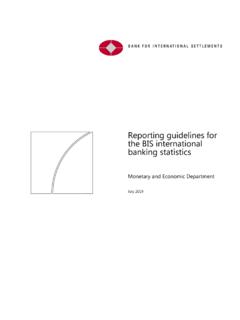Transcription of Labour markets and inflation in the wake of the pandemic
1 BIS Bulletin No 47 Labour markets and inflation in the wake of the pandemic Frederic Boissay, Emanuel Kohlscheen, Richhild Moessner and Daniel Rees 27 October 2021 BIS Bulletins are written by staff members of the Bank for International Settlements, and from time to time by other economists, and are published by the Bank. The papers are on subjects of topical interest and are technical in character. The views expressed in them are those of their authors and not necessarily the views of the BIS. The authors are grateful to Emese Kuruc, Alberto Americo and Albert Pierres Tejada for excellent analysis and research assistance, and to Louisa Wagner for administrative support. The editor of the BIS Bulletin series is Hyun Song Shin.
2 This publication is available on the BIS website ( ). Bank for International Settlements 2021. All rights reserved. Brief excerpts may be reproduced or translated provided the source is stated. ISSN: 2708-0420 (online) ISBN: 978-92-9197-517-3 (online) BIS Bulletin 1 Frederic Boissay Emanuel Kohlscheen Richhild Moessner Daniel Rees Labour markets and inflation in the wake of the pandemic Key takeaways The pandemic had a significant effect on Labour markets . Working hours fell sharply almost everywhere, but the drivers of these declines varied greatly across countries, depending on whether policies to protect worker-firm relationships were in place. Labour markets have bounced back faster than after recent recessions, albeit unevenly.
3 Even in countries where unemployment rates remain high, job vacancies have risen, including in the sectors hardest hit by the pandemic . Frictions are most pronounced where policy responses did not protect worker-firm relationships. Wages are generally rising more slowly than before the pandemic . However, there is significant dispersion across sectors. Wages are rising fastest in sectors such as information & communications where the pandemic boosted demand, and also in high-contact sectors such as recreation where Labour supply has receded. A generalised pickup in wage growth still seems unlikely, even though some countries and sectors have seen increases. However, a retreat in globalisation could make inflation more responsive to Labour market pressures.
4 Introduction Labour market conditions deteriorated significantly during the pandemic recession. But despite the extraordinary decline in working hours at the pandemic s height, forward-looking indicators point to a faster-than-usual Labour market recovery, at least in advanced economies (AEs). As a consequence, concerns about widespread scarring have receded even as the extent of needed Labour force reallocation and the presence of hiring frictions become more evident. In this Bulletin, we review global Labour market developments since the start of the pandemic and ask if the resulting shifts in Labour demand and supply, together with other pandemic -induced changes, will put upward pressure on wages and inflation .
5 Labour markets during the crisis The early stages of the Covid-19 pandemic saw an unprecedented global decline in total working hours. During the broad lockdowns of mid-2020, they dropped by between 10 and 20% in the major AEs, much more than in previous recessions (Graph 1). The decline in many emerging market economies (EMEs) was even larger. The drivers of this decline in total working hours differed across countries. In some, such as the United States and Canada, the reductions largely reflected higher unemployment. In others, such as Japan and many European countries, widespread use of furloughs and short-time work arrangements saw lower average working hours play a bigger role. Lower Labour force participation (LFP) accounted for an 2 BIS Bulletin especially large share of the adjustment in many EMEs.
6 In Brazil, Mexico and South Africa, participation rates initially dropped by between 4 and 12 percentage points. More generally, employment in the informal sector fell by more than in the formal sector in many EMEs. This stands in contrast to the sector s typical role as a buffer during This time the informal sector was especially vulnerable, given its concentration in contact-intensive activities. Total working hours have rebounded sharply, but remain below pre- pandemic levels, and in most countries they lag the recovery in output. Differing policy responses account for part of the differences in Labour market outcomes. Among the AEs, countries fell into two categories. In the first, which included many countries in Europe, governments propped up employment through short-time work schemes, in some cases covering more than 30% of the workforce at the crisis peak.
7 In some jurisdictions, these schemes were extended well beyond the initial phase of the pandemic . These countries saw only a modest increase in unemployment much smaller than would have been expected based on historical relationships given the collapse in output. In the second category, notably the United States and Canada, governments relied less on such schemes, so that unemployment rates rose much more, in line with historical relationships. That said, and in stark contrast to past recoveries, unemployment rates in these countries have fallen quickly, defying the jobless recovery pattern familiar after recessions in recent decades. The rebound in Labour markets reflects the recession s unusual nature, with artificially suppressed activities and few corporate bankruptcies.
8 Wage developments suggest the crisis hit Labour demand and supply Wages have grown more slowly than before the pandemic in most countries, in line with the sharp deterioration in Labour market conditions (Graph 2, left-hand panel).2 A notable exception is the United States, where some measures even pointed to strong wage growth. This, however, was driven largely by 1 See Ahn et al (2019). 2 Budianto et al (2021). Working hours declined everywhere, but in different ways1 In per cent Graph 1 US EA Other AEs EMEs 1 Changes relative to Q4 2019; for the regions, simple averages. Other AEs = AU, CA, GB, JP and SE. EMEs = CL, KR, MX, PL and ZA. Definitions differ among economies. Sources: ILO; Datastream; national data; BIS calculations.
9 BIS Bulletin 3 composition effects, as low wage earners were disproportionately likely to lose their jobs in the Measures that hold Labour force composition fixed did not show such an acceleration. Wage growth has shown a large dispersion across industries. Wages have grown the fastest in the expanding IT sector, but they have also increased faster than average in some hard-hit industries, most notably recreation (Graph 2, centre panel). One possibility is that the supply of Labour has changed, not just demand for it, eg workers could be more reluctant to work in industries perceived as risky. Econometric evidence supports the hypothesis that developments in Labour supply and demand both influenced sectoral wages growth.
10 Among low-contact industries, faster employment growth tended to go together with faster wage growth, consistent with higher demand. However, in high-contact ones, wages increased while employment declined, which suggests a pull-back in Labour supply and short-term frictions in rehiring after large layoffs (Graph 2, right-hand panel). Labour markets are recovering, albeit unevenly Labour markets are recovering. Hours worked have increased and, in countries where they rose, unemployment rates have fallen much more than after previous recessions. But the process has been far from uniform across indicators. Job vacancy rates have risen sharply (Graph 3, left-hand panel). In the United States, Canada and Australia, vacancies are at historical highs, especially in hard-hit sectors (centre panel).

















